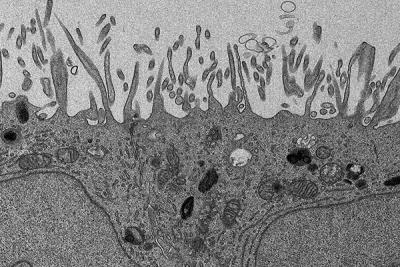
An electron microscopy image of human retinal cells, which were analyzed in a new study on a rare eye disease known as MacTel. The cells were created using induced pluripotent stem cell technology. Credit: Kevin Eade, Scott Henderson and Kimberly Vanderpool
NEI-funded research at Scripps Research Institute and Lowy Medical Research Institute, both in La Jolla, California, has turned up more than a dozen gene variants linked to MacTel, a rare eye disease. The variants are likely causing the condition to develop and worsen for a significant share of patients.
The discovery, made in collaboration with Columbia University in New York and UC San Diego, provides a new avenue to pursue for diagnosis and treatment. It also sheds light on fundamental aspects of metabolism in the retina, a tissue with one of the highest energy demands in the human body. Findings appear today in the journal Nature Metabolism.
MacTel, short for “macular telangiectasia type 2,” is a progressive and debilitating eye disease that occurs in roughly one out of 5,000 people, or about 2 million people worldwide. A disease of the retina, the light-sensing tissue at the back of the eye, MacTel causes a gradual deterioration of central vision, interfering with critical tasks such as reading and driving.
Read more at Scripps Research.